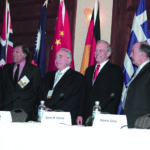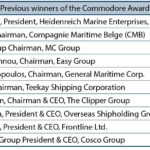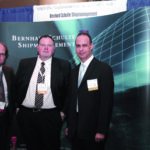(CMA) was created as a network of shipping people, and remains a conduit for the exchange of information and a source of camaraderie and fellowship that is unique and vital to the shipping community. In 2003, the CMA celebrated its 20th anniversary. The association connects more than 1,300 members who represent 450 companies and organizations.
The CMA presented the North America’s premier international shipping and trade conference and exposition SHIPPING 2010. From their website, »The[ds_preview] Connecticut Maritime Association is a non-profit organization built by its members for its members. It is an Association made of individuals representing every aspect of shipping and international trade.«
The CMA‘s »Shipping« event, held each March in Stamford, Connecticut, has gained a reputation as the premier shipping gathering in North America and a »must-attend« event on the business calendar. A dynamic and topical seminar program, combined with cutting edge exhibits and an enormous range of networking opportunities attracts over 1,700 major domestic and international industry players each year. The event culminates in the Commodore Gala Dinner, where an individual, selected by the CMA Board, is presented with the CMA Commodore Award in recognition of outstanding contribution to the maritime industry.
Shipping 2010 brought together over 2300 visitors to the Hilton Hotel in Stamford. Amid a tumult of activity, that astounded even the most veteran of CMA guests, the Hilton was transformed for 3 days into a shipping bazaar. This year’s event was taking place at a time of some uncertainty for shipping while many commercial, technical and regulatory issues are taking centre stage in the industry this year. They came from all over the world … France, Norway, the United Kingdom, Greece, Germany, Egypt, Japan, China, Singapore, India, South Korea, Nigeria, Mexico, the Bahamas, Barbados, and more to participate. Over 2,300 visitors and 120 plus exhibitors represented over 40 countries.
A distinctive feature of the annual CMA show is that it brings together commercial and operational aspects of the shipping business. The CMA is therefore confident that the show will attract great interest and indications so far bear that out.
A working group based in the Connecticut tri-state area that includes shipowners, managers, lawyers, insurers, shipbrokers and response specialists has devised the event programme. The associated conference reflects these twin major commercial and operational themes.
In the opening conference session, CMA president Beth Wilson-Jordan welcomed delegates. There were also presentations by the leaders of several key international shipping industry organisations. These were scheduled to include Dr. Hermann Klein, chairman of the International Association of Classification Societies, Graham Westgarth, chairman of Intertanko, Nicholas Pappadakis, chairman of Intercargo, Spyros Polemis, chairman of the International Chamber of Shipping, and Roberto Giorgi, InterManager chairman. Seminar sessions went from high-point to high-point with strong words from the heads of the industry’s major trade associations.
A special message came from Efthimios E. Mitropoulos, Secretary-General from the International Maritime Organization (IMO). In a video message recorded Mitropoulos: »In «real life” I addressed the opening of the 60th session of the Marine Environment Protection Committee of the International Maritime Organization at its London Headquarters this morning – which makes the theme that the organizers of this event have asked me to speak about, namely «IMO’s role in addressing GHG reductions from shipping”, particularly pertinent. For it is through the MEPC that IMO’s work in this area has been focused. Indeed, at this week’s session, we expect, as ever, that important progress will be made towards the ultimate objective: a coherent and comprehensive regulatory framework to limit or reduce greenhouse gas emissions from international shipping. …
… The agreed measures were intended for voluntary application until the Committee‘s current session during which important discussions will take place on the proposed measures’ scope of application and enactment, as the Committee will consider making them mandatory under MARPOL Annex VI.
They include an Energy Efficiency Design Index, which will set a minimum requirement for the energy efficiency of new ships and thus stimulate innovation and technical development of all elements influencing the fuel efficiency of a ship. The index would cover the main segments of the world fleet (tankers, bulk carriers, container ships, gas carriers, general cargo ships and so on) representing the largest emitters, although, without additional incentives, it may take some 20 years to reach the required level of coverage in the world fleet, if the usual economic life of ships is taken into account. The reduction levels for different segments of the world merchant fleet – by type and size – will be one of the key topics due for consideration by the MEPC this week as it addresses the mandatory application of the index for new ships, from a date to be decided.
Another part of the package is the Ship Energy Efficiency Management Plan for new and existing ships, which incorporates best practices for fuel-efficient ship operation, as well as guidelines for the use of an Energy Efficiency Operational Indicator for new and existing ships. This indicator enables operators to measure the fuel efficiency of a ship in operation and to gauge the effect of any changes in operation, such as improved voyage planning or more frequent propeller cleaning, or the introduction of technical measures such as waste heat recovery systems or a new, more efficient propeller. The Ship Energy Efficiency Management Plan will assist the shipping industry in achieving these potential energy savings.
While this package of technical and operational measures is a very important step in ensuring that the shipping industry has the necessary mechanisms to enable it to reduce its GHG emissions, IMO has, nevertheless, recognized that these measures alone would not be sufficient to reduce the amount of GHG emissions from international shipping to a satisfactory level, particularly in view of the long-term growth projections for world trade. Market-based mechanisms have, therefore, also been considered by the Committee, in line with its GHG work plan. A market-based mechanism is meant to serve two main purposes: the off-setting of growing ship emissions, and providing a fiscal incentive for the maritime industry to invest in more fuel-efficient ships and technologies and to operate ships in a more energy-efficient manner.
The MEPC, having previously agreed that a market-based instrument should form part of any comprehensive package of measures for the regulation of GHG emissions from international shipping, has further agreed that any regulatory GHG regime applied to international shipping should be developed and enacted by IMO as the sole competent international organization assigned the global mandate to regulate all aspects of international shipping. As shipping is a global industry and ships are competing in a single global market, it must be regulated at the global level to be environmentally effective and to maintain a level playing field for all ships, irrespective of flag or ownership.«
A major theme was the environmental aspect. While ship owners, ship operators, ship managers, charterers and the marine transportation world contend with moving cargoes in today‘s challenging freight market, governments around the world and extra government organizations like the UN‘s IMO, continue their unrestrained environmental, trade and regulatory actions. There is an ever growing flow of regulations, rules, requirements, responsibilities, threat and obligations, many of which dictate standards that have not been agreed internationally, or in some cases for which the technologies to meet those standards do not yet exist. All of these must be planned for, managed, implemented and paid for, regardless the freight environment.
Most ship owners have no objection to the spirit of these regulations as long as they apply and are implemented by all, but to get to that point is the burdensome task of the industry‘s trade associations. Furthermore, it seems that every solution creates it own set of problems!
This one of the sessions, it was present an update on the actions of governing bodies that owners, operators and cargo.
Behind these topics, every year the CMA given its annual Commodore Award to a person in the international maritime industry who has contributed to the growth and development of the industry. Mr. Louis-Dreyfus is President of Louis Dreyfus Armateurs Group, which has been a major player in the drybulk transportation sector since 1893. Cetragpa SNC, a fully owned subsidiary, operates a diversified fleet of about 20 dry bulk cargo vessels ranging in size from 20,000 to 180,000 tons, and is a leader in the global dry bulk transportation business. Long a proponent of Short Sea Shipping, the company has been expanding its Roll- On/Roll Off business, LD Lines.
The Award ceremony took place during the Gala dinner in Stamford, Connecticut and guests included his wife, Mrs. Anne Louis-Dreyfus, Mr. Edouard Louis-Dreyfus, vice-president and Mr. Gildas Maire, chief operating officer of LDA group. In his speech, Mr Louis-Dreyfus emphasized the need for the shipping industry, in today’s trouble waters, to return to its basic values : trust, loyalty and common sense. Philippe Louis-Dreyfus joins a distinguished list of maritime leaders who have already received the Award, including, since 2000.
























